Business Law BMP4002: Legal Context & Business Organizations in UK
VerifiedAdded on 2023/06/14
|9
|2829
|394
Report
AI Summary
This report provides an overview of the legal context for business organizations in the UK, covering key aspects of business law. It discusses various types of laws including the Equity Act 2010 and the Health and Safety Act 1974, business transaction management, and vicarious liability. The report also examines business liability in negligence, director roles and responsibilities, termination of partnerships, Memorandum of Association (MOA), and Articles of Association (AOA). Furthermore, it details the legal business structures in the UK, such as sole proprietorships, general partnerships, partnerships, and limited liability companies (LLC), including their formation, taxation, liabilities, dissolution, advantages, and disadvantages. The report concludes with a recommendation for IOM Solutions, advising on the most suitable business structure for their expanding electrical parts business.
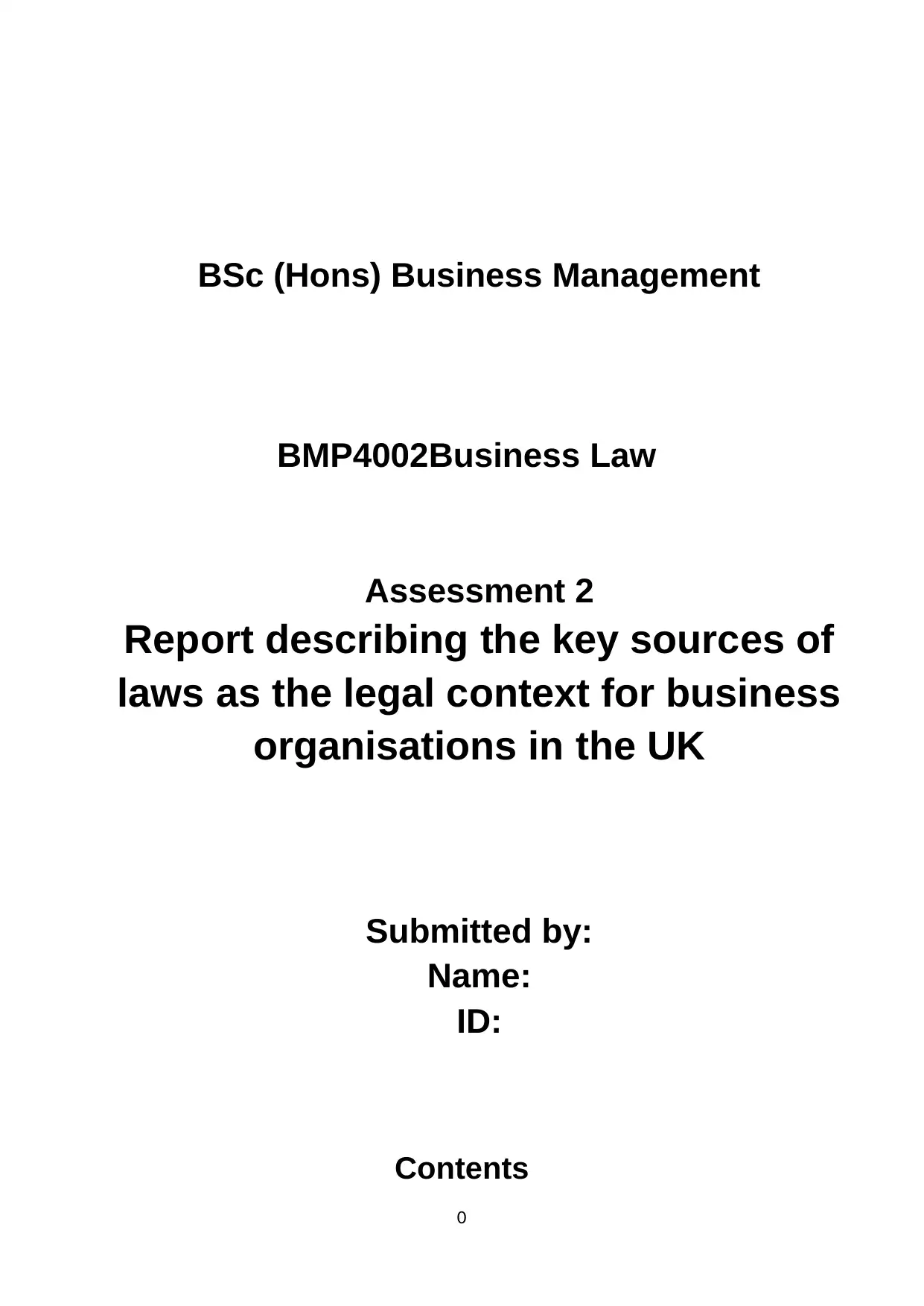
BSc (Hons) Business Management
BMP4002Business Law
Assessment 2
Report describing the key sources of
laws as the legal context for business
organisations in the UK
Submitted by:
Name:
ID:
Contents
0
BMP4002Business Law
Assessment 2
Report describing the key sources of
laws as the legal context for business
organisations in the UK
Submitted by:
Name:
ID:
Contents
0
Paraphrase This Document
Need a fresh take? Get an instant paraphrase of this document with our AI Paraphraser
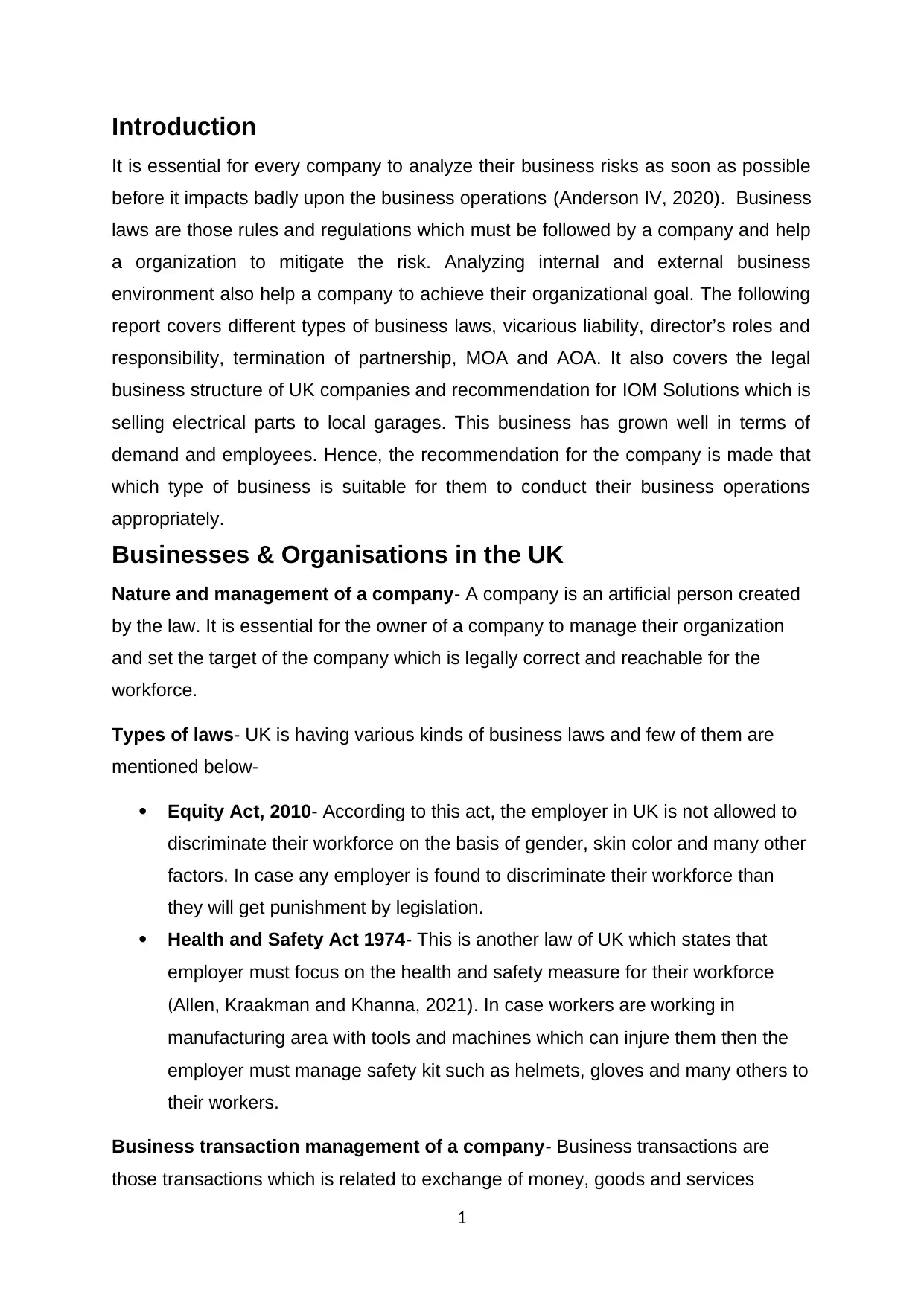
Introduction
It is essential for every company to analyze their business risks as soon as possible
before it impacts badly upon the business operations (Anderson IV, 2020). Business
laws are those rules and regulations which must be followed by a company and help
a organization to mitigate the risk. Analyzing internal and external business
environment also help a company to achieve their organizational goal. The following
report covers different types of business laws, vicarious liability, director’s roles and
responsibility, termination of partnership, MOA and AOA. It also covers the legal
business structure of UK companies and recommendation for IOM Solutions which is
selling electrical parts to local garages. This business has grown well in terms of
demand and employees. Hence, the recommendation for the company is made that
which type of business is suitable for them to conduct their business operations
appropriately.
Businesses & Organisations in the UK
Nature and management of a company- A company is an artificial person created
by the law. It is essential for the owner of a company to manage their organization
and set the target of the company which is legally correct and reachable for the
workforce.
Types of laws- UK is having various kinds of business laws and few of them are
mentioned below-
Equity Act, 2010- According to this act, the employer in UK is not allowed to
discriminate their workforce on the basis of gender, skin color and many other
factors. In case any employer is found to discriminate their workforce than
they will get punishment by legislation.
Health and Safety Act 1974- This is another law of UK which states that
employer must focus on the health and safety measure for their workforce
(Allen, Kraakman and Khanna, 2021). In case workers are working in
manufacturing area with tools and machines which can injure them then the
employer must manage safety kit such as helmets, gloves and many others to
their workers.
Business transaction management of a company- Business transactions are
those transactions which is related to exchange of money, goods and services
1
It is essential for every company to analyze their business risks as soon as possible
before it impacts badly upon the business operations (Anderson IV, 2020). Business
laws are those rules and regulations which must be followed by a company and help
a organization to mitigate the risk. Analyzing internal and external business
environment also help a company to achieve their organizational goal. The following
report covers different types of business laws, vicarious liability, director’s roles and
responsibility, termination of partnership, MOA and AOA. It also covers the legal
business structure of UK companies and recommendation for IOM Solutions which is
selling electrical parts to local garages. This business has grown well in terms of
demand and employees. Hence, the recommendation for the company is made that
which type of business is suitable for them to conduct their business operations
appropriately.
Businesses & Organisations in the UK
Nature and management of a company- A company is an artificial person created
by the law. It is essential for the owner of a company to manage their organization
and set the target of the company which is legally correct and reachable for the
workforce.
Types of laws- UK is having various kinds of business laws and few of them are
mentioned below-
Equity Act, 2010- According to this act, the employer in UK is not allowed to
discriminate their workforce on the basis of gender, skin color and many other
factors. In case any employer is found to discriminate their workforce than
they will get punishment by legislation.
Health and Safety Act 1974- This is another law of UK which states that
employer must focus on the health and safety measure for their workforce
(Allen, Kraakman and Khanna, 2021). In case workers are working in
manufacturing area with tools and machines which can injure them then the
employer must manage safety kit such as helmets, gloves and many others to
their workers.
Business transaction management of a company- Business transactions are
those transactions which is related to exchange of money, goods and services
1
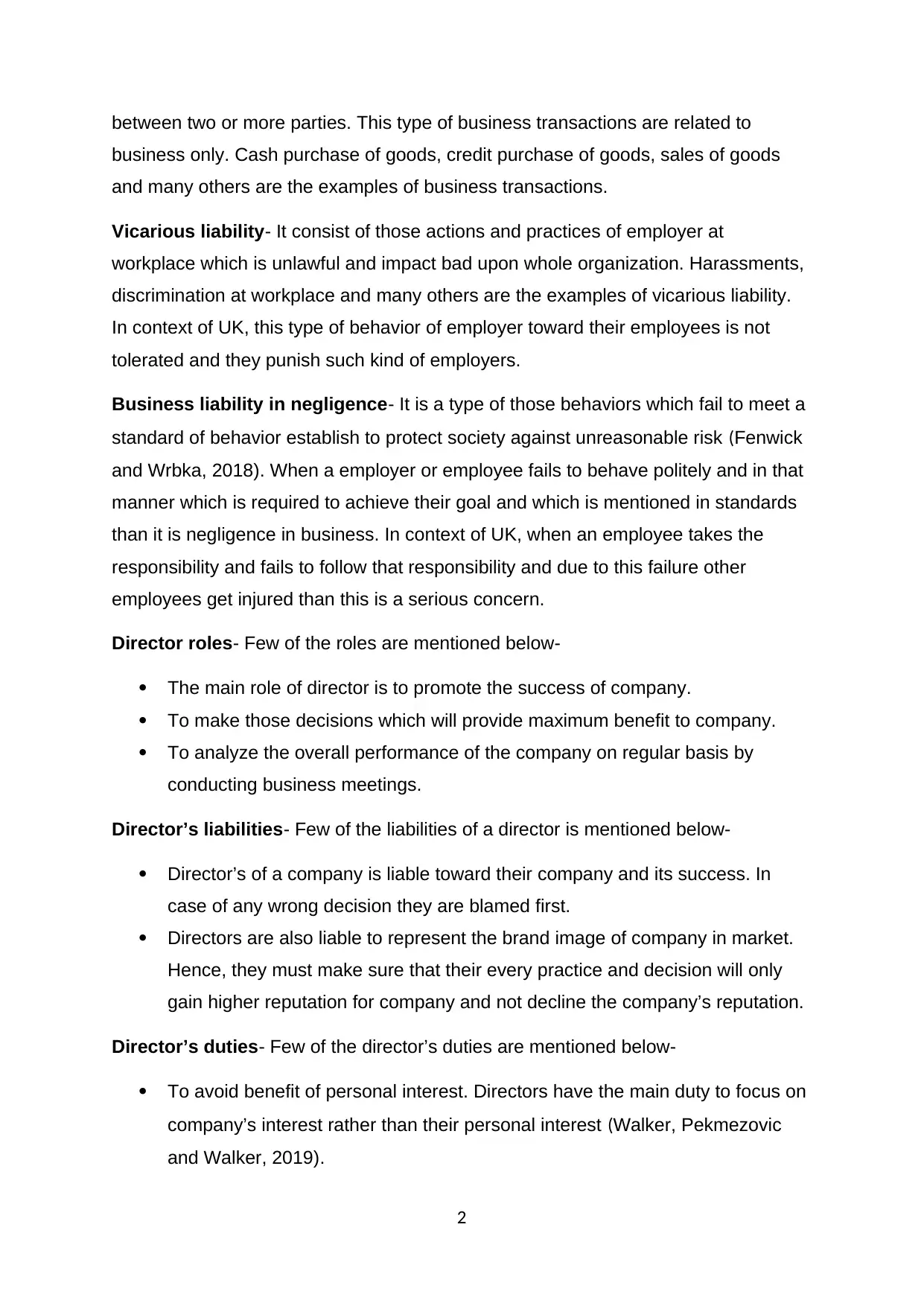
between two or more parties. This type of business transactions are related to
business only. Cash purchase of goods, credit purchase of goods, sales of goods
and many others are the examples of business transactions.
Vicarious liability- It consist of those actions and practices of employer at
workplace which is unlawful and impact bad upon whole organization. Harassments,
discrimination at workplace and many others are the examples of vicarious liability.
In context of UK, this type of behavior of employer toward their employees is not
tolerated and they punish such kind of employers.
Business liability in negligence- It is a type of those behaviors which fail to meet a
standard of behavior establish to protect society against unreasonable risk (Fenwick
and Wrbka, 2018). When a employer or employee fails to behave politely and in that
manner which is required to achieve their goal and which is mentioned in standards
than it is negligence in business. In context of UK, when an employee takes the
responsibility and fails to follow that responsibility and due to this failure other
employees get injured than this is a serious concern.
Director roles- Few of the roles are mentioned below-
The main role of director is to promote the success of company.
To make those decisions which will provide maximum benefit to company.
To analyze the overall performance of the company on regular basis by
conducting business meetings.
Director’s liabilities- Few of the liabilities of a director is mentioned below-
Director’s of a company is liable toward their company and its success. In
case of any wrong decision they are blamed first.
Directors are also liable to represent the brand image of company in market.
Hence, they must make sure that their every practice and decision will only
gain higher reputation for company and not decline the company’s reputation.
Director’s duties- Few of the director’s duties are mentioned below-
To avoid benefit of personal interest. Directors have the main duty to focus on
company’s interest rather than their personal interest (Walker, Pekmezovic
and Walker, 2019).
2
business only. Cash purchase of goods, credit purchase of goods, sales of goods
and many others are the examples of business transactions.
Vicarious liability- It consist of those actions and practices of employer at
workplace which is unlawful and impact bad upon whole organization. Harassments,
discrimination at workplace and many others are the examples of vicarious liability.
In context of UK, this type of behavior of employer toward their employees is not
tolerated and they punish such kind of employers.
Business liability in negligence- It is a type of those behaviors which fail to meet a
standard of behavior establish to protect society against unreasonable risk (Fenwick
and Wrbka, 2018). When a employer or employee fails to behave politely and in that
manner which is required to achieve their goal and which is mentioned in standards
than it is negligence in business. In context of UK, when an employee takes the
responsibility and fails to follow that responsibility and due to this failure other
employees get injured than this is a serious concern.
Director roles- Few of the roles are mentioned below-
The main role of director is to promote the success of company.
To make those decisions which will provide maximum benefit to company.
To analyze the overall performance of the company on regular basis by
conducting business meetings.
Director’s liabilities- Few of the liabilities of a director is mentioned below-
Director’s of a company is liable toward their company and its success. In
case of any wrong decision they are blamed first.
Directors are also liable to represent the brand image of company in market.
Hence, they must make sure that their every practice and decision will only
gain higher reputation for company and not decline the company’s reputation.
Director’s duties- Few of the director’s duties are mentioned below-
To avoid benefit of personal interest. Directors have the main duty to focus on
company’s interest rather than their personal interest (Walker, Pekmezovic
and Walker, 2019).
2
⊘ This is a preview!⊘
Do you want full access?
Subscribe today to unlock all pages.

Trusted by 1+ million students worldwide
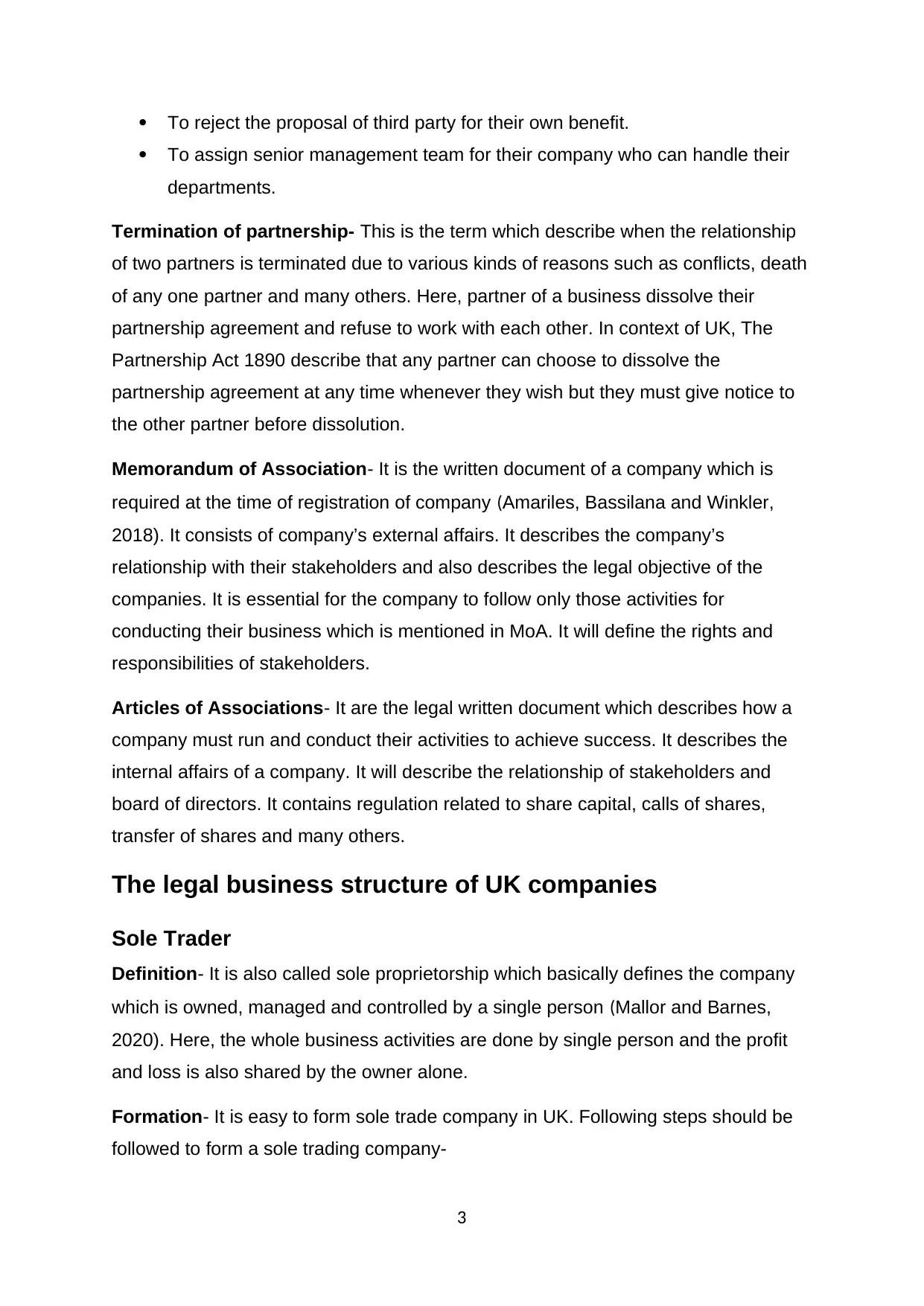
To reject the proposal of third party for their own benefit.
To assign senior management team for their company who can handle their
departments.
Termination of partnership- This is the term which describe when the relationship
of two partners is terminated due to various kinds of reasons such as conflicts, death
of any one partner and many others. Here, partner of a business dissolve their
partnership agreement and refuse to work with each other. In context of UK, The
Partnership Act 1890 describe that any partner can choose to dissolve the
partnership agreement at any time whenever they wish but they must give notice to
the other partner before dissolution.
Memorandum of Association- It is the written document of a company which is
required at the time of registration of company (Amariles, Bassilana and Winkler,
2018). It consists of company’s external affairs. It describes the company’s
relationship with their stakeholders and also describes the legal objective of the
companies. It is essential for the company to follow only those activities for
conducting their business which is mentioned in MoA. It will define the rights and
responsibilities of stakeholders.
Articles of Associations- It are the legal written document which describes how a
company must run and conduct their activities to achieve success. It describes the
internal affairs of a company. It will describe the relationship of stakeholders and
board of directors. It contains regulation related to share capital, calls of shares,
transfer of shares and many others.
The legal business structure of UK companies
Sole Trader
Definition- It is also called sole proprietorship which basically defines the company
which is owned, managed and controlled by a single person (Mallor and Barnes,
2020). Here, the whole business activities are done by single person and the profit
and loss is also shared by the owner alone.
Formation- It is easy to form sole trade company in UK. Following steps should be
followed to form a sole trading company-
3
To assign senior management team for their company who can handle their
departments.
Termination of partnership- This is the term which describe when the relationship
of two partners is terminated due to various kinds of reasons such as conflicts, death
of any one partner and many others. Here, partner of a business dissolve their
partnership agreement and refuse to work with each other. In context of UK, The
Partnership Act 1890 describe that any partner can choose to dissolve the
partnership agreement at any time whenever they wish but they must give notice to
the other partner before dissolution.
Memorandum of Association- It is the written document of a company which is
required at the time of registration of company (Amariles, Bassilana and Winkler,
2018). It consists of company’s external affairs. It describes the company’s
relationship with their stakeholders and also describes the legal objective of the
companies. It is essential for the company to follow only those activities for
conducting their business which is mentioned in MoA. It will define the rights and
responsibilities of stakeholders.
Articles of Associations- It are the legal written document which describes how a
company must run and conduct their activities to achieve success. It describes the
internal affairs of a company. It will describe the relationship of stakeholders and
board of directors. It contains regulation related to share capital, calls of shares,
transfer of shares and many others.
The legal business structure of UK companies
Sole Trader
Definition- It is also called sole proprietorship which basically defines the company
which is owned, managed and controlled by a single person (Mallor and Barnes,
2020). Here, the whole business activities are done by single person and the profit
and loss is also shared by the owner alone.
Formation- It is easy to form sole trade company in UK. Following steps should be
followed to form a sole trading company-
3
Paraphrase This Document
Need a fresh take? Get an instant paraphrase of this document with our AI Paraphraser
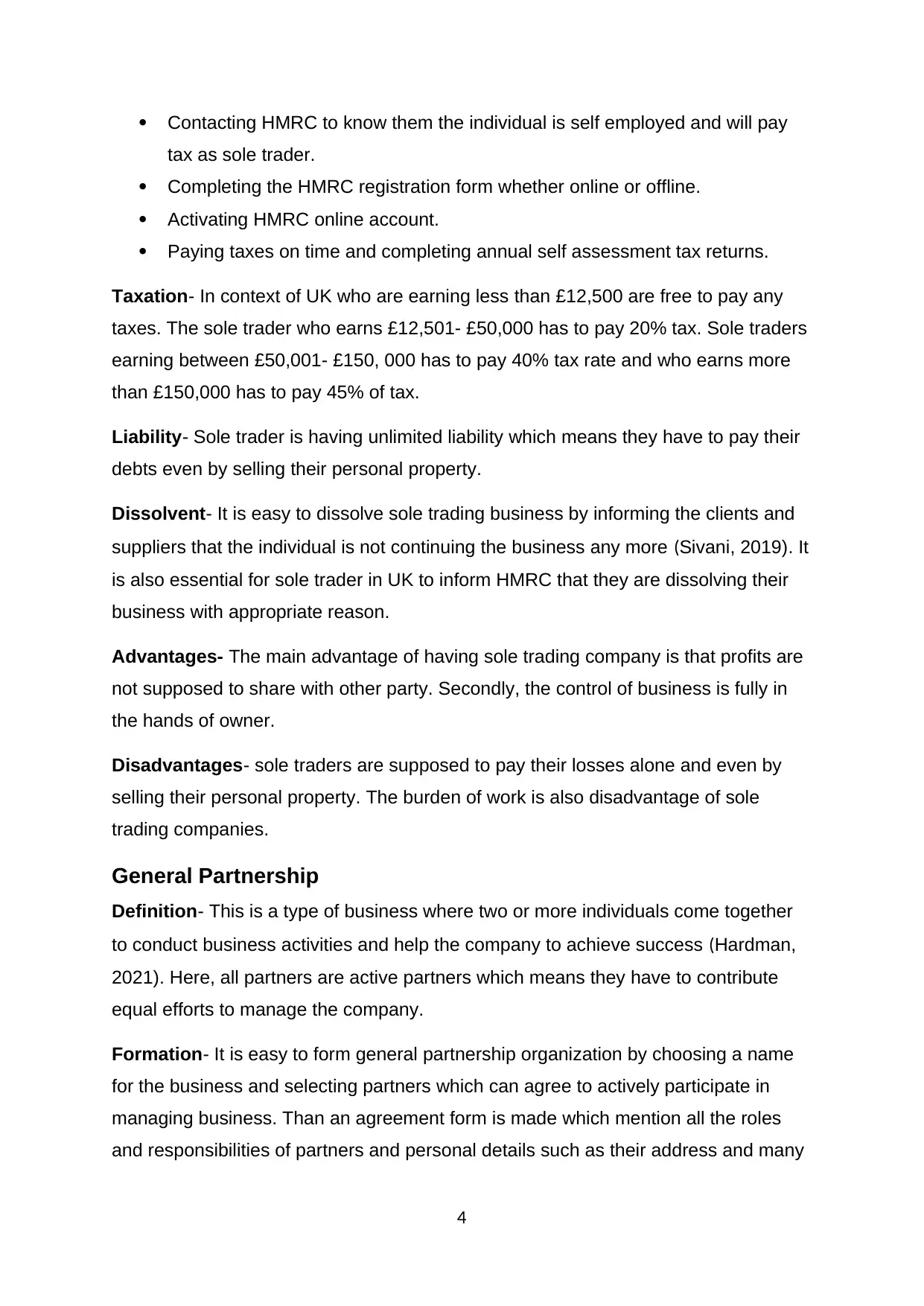
Contacting HMRC to know them the individual is self employed and will pay
tax as sole trader.
Completing the HMRC registration form whether online or offline.
Activating HMRC online account.
Paying taxes on time and completing annual self assessment tax returns.
Taxation- In context of UK who are earning less than £12,500 are free to pay any
taxes. The sole trader who earns £12,501- £50,000 has to pay 20% tax. Sole traders
earning between £50,001- £150, 000 has to pay 40% tax rate and who earns more
than £150,000 has to pay 45% of tax.
Liability- Sole trader is having unlimited liability which means they have to pay their
debts even by selling their personal property.
Dissolvent- It is easy to dissolve sole trading business by informing the clients and
suppliers that the individual is not continuing the business any more (Sivani, 2019). It
is also essential for sole trader in UK to inform HMRC that they are dissolving their
business with appropriate reason.
Advantages- The main advantage of having sole trading company is that profits are
not supposed to share with other party. Secondly, the control of business is fully in
the hands of owner.
Disadvantages- sole traders are supposed to pay their losses alone and even by
selling their personal property. The burden of work is also disadvantage of sole
trading companies.
General Partnership
Definition- This is a type of business where two or more individuals come together
to conduct business activities and help the company to achieve success (Hardman,
2021). Here, all partners are active partners which means they have to contribute
equal efforts to manage the company.
Formation- It is easy to form general partnership organization by choosing a name
for the business and selecting partners which can agree to actively participate in
managing business. Than an agreement form is made which mention all the roles
and responsibilities of partners and personal details such as their address and many
4
tax as sole trader.
Completing the HMRC registration form whether online or offline.
Activating HMRC online account.
Paying taxes on time and completing annual self assessment tax returns.
Taxation- In context of UK who are earning less than £12,500 are free to pay any
taxes. The sole trader who earns £12,501- £50,000 has to pay 20% tax. Sole traders
earning between £50,001- £150, 000 has to pay 40% tax rate and who earns more
than £150,000 has to pay 45% of tax.
Liability- Sole trader is having unlimited liability which means they have to pay their
debts even by selling their personal property.
Dissolvent- It is easy to dissolve sole trading business by informing the clients and
suppliers that the individual is not continuing the business any more (Sivani, 2019). It
is also essential for sole trader in UK to inform HMRC that they are dissolving their
business with appropriate reason.
Advantages- The main advantage of having sole trading company is that profits are
not supposed to share with other party. Secondly, the control of business is fully in
the hands of owner.
Disadvantages- sole traders are supposed to pay their losses alone and even by
selling their personal property. The burden of work is also disadvantage of sole
trading companies.
General Partnership
Definition- This is a type of business where two or more individuals come together
to conduct business activities and help the company to achieve success (Hardman,
2021). Here, all partners are active partners which means they have to contribute
equal efforts to manage the company.
Formation- It is easy to form general partnership organization by choosing a name
for the business and selecting partners which can agree to actively participate in
managing business. Than an agreement form is made which mention all the roles
and responsibilities of partners and personal details such as their address and many
4
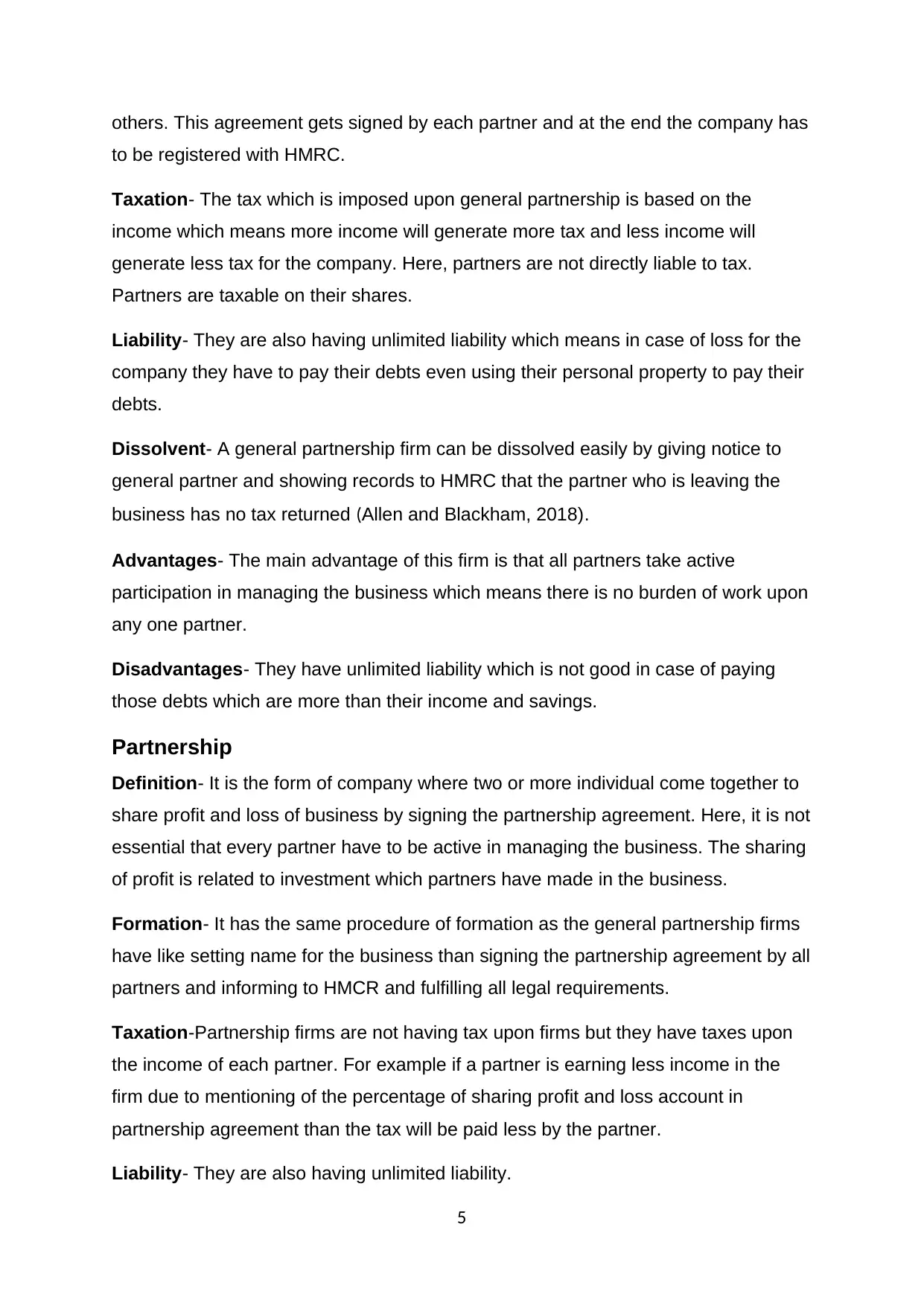
others. This agreement gets signed by each partner and at the end the company has
to be registered with HMRC.
Taxation- The tax which is imposed upon general partnership is based on the
income which means more income will generate more tax and less income will
generate less tax for the company. Here, partners are not directly liable to tax.
Partners are taxable on their shares.
Liability- They are also having unlimited liability which means in case of loss for the
company they have to pay their debts even using their personal property to pay their
debts.
Dissolvent- A general partnership firm can be dissolved easily by giving notice to
general partner and showing records to HMRC that the partner who is leaving the
business has no tax returned (Allen and Blackham, 2018).
Advantages- The main advantage of this firm is that all partners take active
participation in managing the business which means there is no burden of work upon
any one partner.
Disadvantages- They have unlimited liability which is not good in case of paying
those debts which are more than their income and savings.
Partnership
Definition- It is the form of company where two or more individual come together to
share profit and loss of business by signing the partnership agreement. Here, it is not
essential that every partner have to be active in managing the business. The sharing
of profit is related to investment which partners have made in the business.
Formation- It has the same procedure of formation as the general partnership firms
have like setting name for the business than signing the partnership agreement by all
partners and informing to HMCR and fulfilling all legal requirements.
Taxation-Partnership firms are not having tax upon firms but they have taxes upon
the income of each partner. For example if a partner is earning less income in the
firm due to mentioning of the percentage of sharing profit and loss account in
partnership agreement than the tax will be paid less by the partner.
Liability- They are also having unlimited liability.
5
to be registered with HMRC.
Taxation- The tax which is imposed upon general partnership is based on the
income which means more income will generate more tax and less income will
generate less tax for the company. Here, partners are not directly liable to tax.
Partners are taxable on their shares.
Liability- They are also having unlimited liability which means in case of loss for the
company they have to pay their debts even using their personal property to pay their
debts.
Dissolvent- A general partnership firm can be dissolved easily by giving notice to
general partner and showing records to HMRC that the partner who is leaving the
business has no tax returned (Allen and Blackham, 2018).
Advantages- The main advantage of this firm is that all partners take active
participation in managing the business which means there is no burden of work upon
any one partner.
Disadvantages- They have unlimited liability which is not good in case of paying
those debts which are more than their income and savings.
Partnership
Definition- It is the form of company where two or more individual come together to
share profit and loss of business by signing the partnership agreement. Here, it is not
essential that every partner have to be active in managing the business. The sharing
of profit is related to investment which partners have made in the business.
Formation- It has the same procedure of formation as the general partnership firms
have like setting name for the business than signing the partnership agreement by all
partners and informing to HMCR and fulfilling all legal requirements.
Taxation-Partnership firms are not having tax upon firms but they have taxes upon
the income of each partner. For example if a partner is earning less income in the
firm due to mentioning of the percentage of sharing profit and loss account in
partnership agreement than the tax will be paid less by the partner.
Liability- They are also having unlimited liability.
5
⊘ This is a preview!⊘
Do you want full access?
Subscribe today to unlock all pages.

Trusted by 1+ million students worldwide
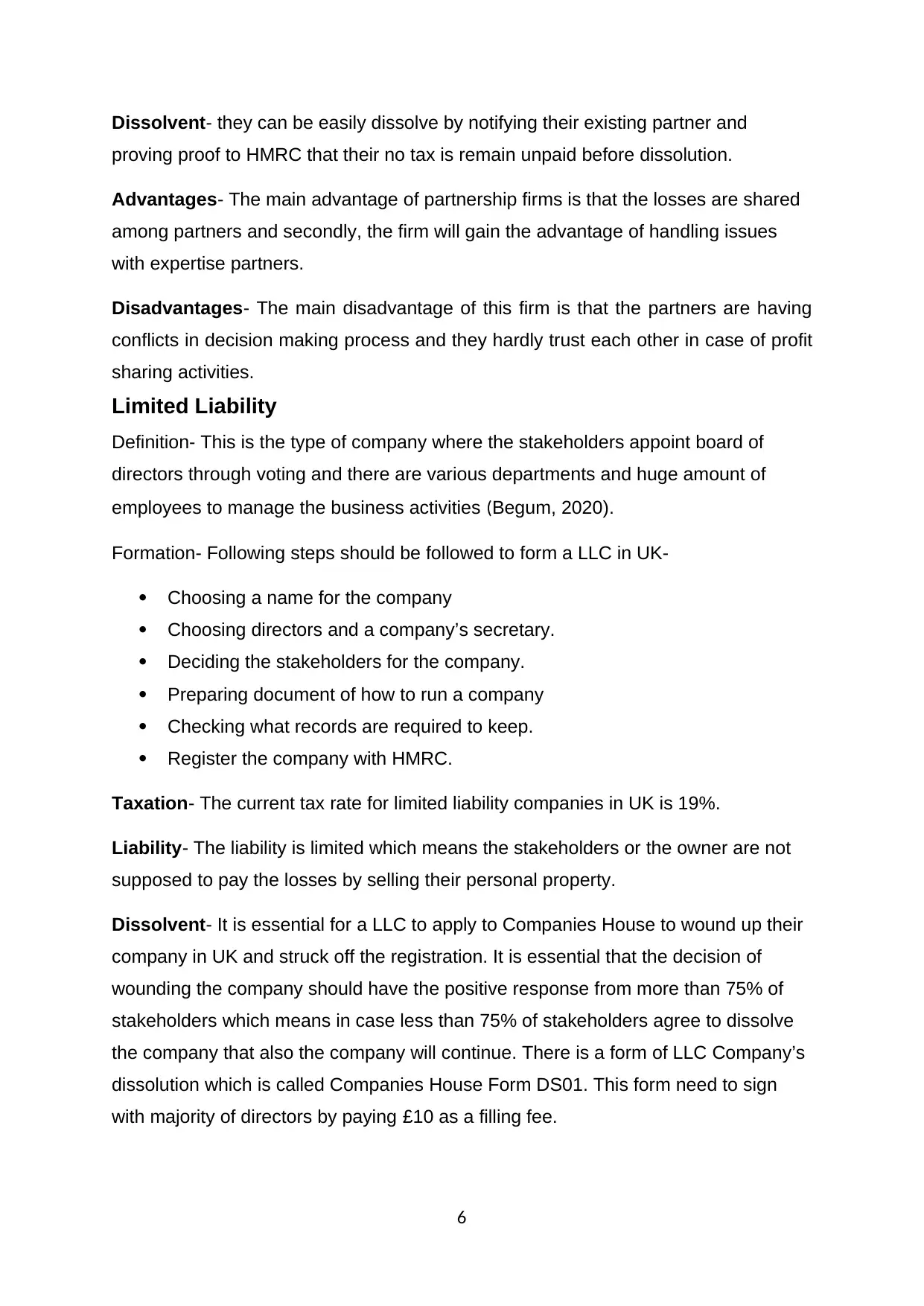
Dissolvent- they can be easily dissolve by notifying their existing partner and
proving proof to HMRC that their no tax is remain unpaid before dissolution.
Advantages- The main advantage of partnership firms is that the losses are shared
among partners and secondly, the firm will gain the advantage of handling issues
with expertise partners.
Disadvantages- The main disadvantage of this firm is that the partners are having
conflicts in decision making process and they hardly trust each other in case of profit
sharing activities.
Limited Liability
Definition- This is the type of company where the stakeholders appoint board of
directors through voting and there are various departments and huge amount of
employees to manage the business activities (Begum, 2020).
Formation- Following steps should be followed to form a LLC in UK-
Choosing a name for the company
Choosing directors and a company’s secretary.
Deciding the stakeholders for the company.
Preparing document of how to run a company
Checking what records are required to keep.
Register the company with HMRC.
Taxation- The current tax rate for limited liability companies in UK is 19%.
Liability- The liability is limited which means the stakeholders or the owner are not
supposed to pay the losses by selling their personal property.
Dissolvent- It is essential for a LLC to apply to Companies House to wound up their
company in UK and struck off the registration. It is essential that the decision of
wounding the company should have the positive response from more than 75% of
stakeholders which means in case less than 75% of stakeholders agree to dissolve
the company that also the company will continue. There is a form of LLC Company’s
dissolution which is called Companies House Form DS01. This form need to sign
with majority of directors by paying £10 as a filling fee.
6
proving proof to HMRC that their no tax is remain unpaid before dissolution.
Advantages- The main advantage of partnership firms is that the losses are shared
among partners and secondly, the firm will gain the advantage of handling issues
with expertise partners.
Disadvantages- The main disadvantage of this firm is that the partners are having
conflicts in decision making process and they hardly trust each other in case of profit
sharing activities.
Limited Liability
Definition- This is the type of company where the stakeholders appoint board of
directors through voting and there are various departments and huge amount of
employees to manage the business activities (Begum, 2020).
Formation- Following steps should be followed to form a LLC in UK-
Choosing a name for the company
Choosing directors and a company’s secretary.
Deciding the stakeholders for the company.
Preparing document of how to run a company
Checking what records are required to keep.
Register the company with HMRC.
Taxation- The current tax rate for limited liability companies in UK is 19%.
Liability- The liability is limited which means the stakeholders or the owner are not
supposed to pay the losses by selling their personal property.
Dissolvent- It is essential for a LLC to apply to Companies House to wound up their
company in UK and struck off the registration. It is essential that the decision of
wounding the company should have the positive response from more than 75% of
stakeholders which means in case less than 75% of stakeholders agree to dissolve
the company that also the company will continue. There is a form of LLC Company’s
dissolution which is called Companies House Form DS01. This form need to sign
with majority of directors by paying £10 as a filling fee.
6
Paraphrase This Document
Need a fresh take? Get an instant paraphrase of this document with our AI Paraphraser
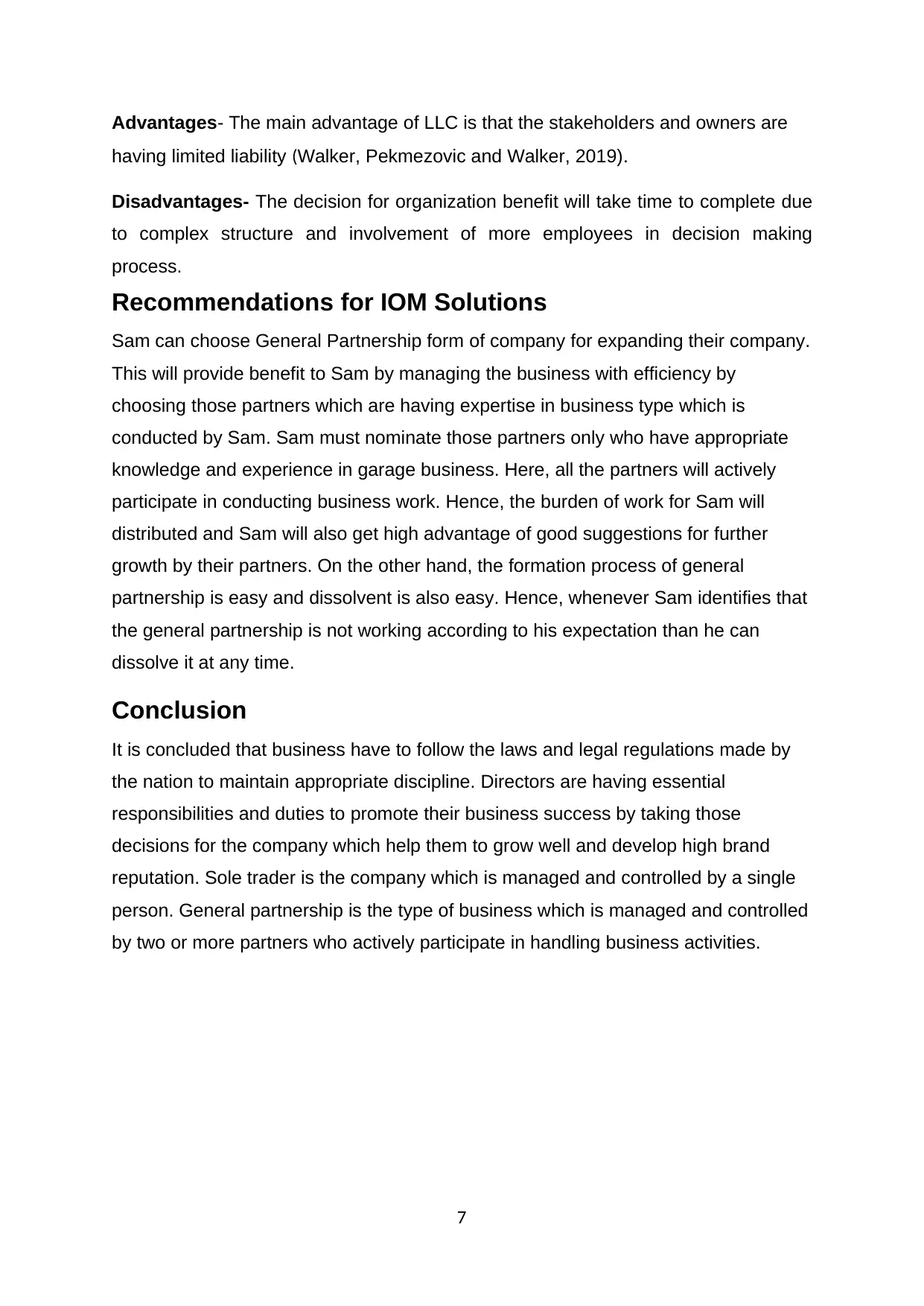
Advantages- The main advantage of LLC is that the stakeholders and owners are
having limited liability (Walker, Pekmezovic and Walker, 2019).
Disadvantages- The decision for organization benefit will take time to complete due
to complex structure and involvement of more employees in decision making
process.
Recommendations for IOM Solutions
Sam can choose General Partnership form of company for expanding their company.
This will provide benefit to Sam by managing the business with efficiency by
choosing those partners which are having expertise in business type which is
conducted by Sam. Sam must nominate those partners only who have appropriate
knowledge and experience in garage business. Here, all the partners will actively
participate in conducting business work. Hence, the burden of work for Sam will
distributed and Sam will also get high advantage of good suggestions for further
growth by their partners. On the other hand, the formation process of general
partnership is easy and dissolvent is also easy. Hence, whenever Sam identifies that
the general partnership is not working according to his expectation than he can
dissolve it at any time.
Conclusion
It is concluded that business have to follow the laws and legal regulations made by
the nation to maintain appropriate discipline. Directors are having essential
responsibilities and duties to promote their business success by taking those
decisions for the company which help them to grow well and develop high brand
reputation. Sole trader is the company which is managed and controlled by a single
person. General partnership is the type of business which is managed and controlled
by two or more partners who actively participate in handling business activities.
7
having limited liability (Walker, Pekmezovic and Walker, 2019).
Disadvantages- The decision for organization benefit will take time to complete due
to complex structure and involvement of more employees in decision making
process.
Recommendations for IOM Solutions
Sam can choose General Partnership form of company for expanding their company.
This will provide benefit to Sam by managing the business with efficiency by
choosing those partners which are having expertise in business type which is
conducted by Sam. Sam must nominate those partners only who have appropriate
knowledge and experience in garage business. Here, all the partners will actively
participate in conducting business work. Hence, the burden of work for Sam will
distributed and Sam will also get high advantage of good suggestions for further
growth by their partners. On the other hand, the formation process of general
partnership is easy and dissolvent is also easy. Hence, whenever Sam identifies that
the general partnership is not working according to his expectation than he can
dissolve it at any time.
Conclusion
It is concluded that business have to follow the laws and legal regulations made by
the nation to maintain appropriate discipline. Directors are having essential
responsibilities and duties to promote their business success by taking those
decisions for the company which help them to grow well and develop high brand
reputation. Sole trader is the company which is managed and controlled by a single
person. General partnership is the type of business which is managed and controlled
by two or more partners who actively participate in handling business activities.
7
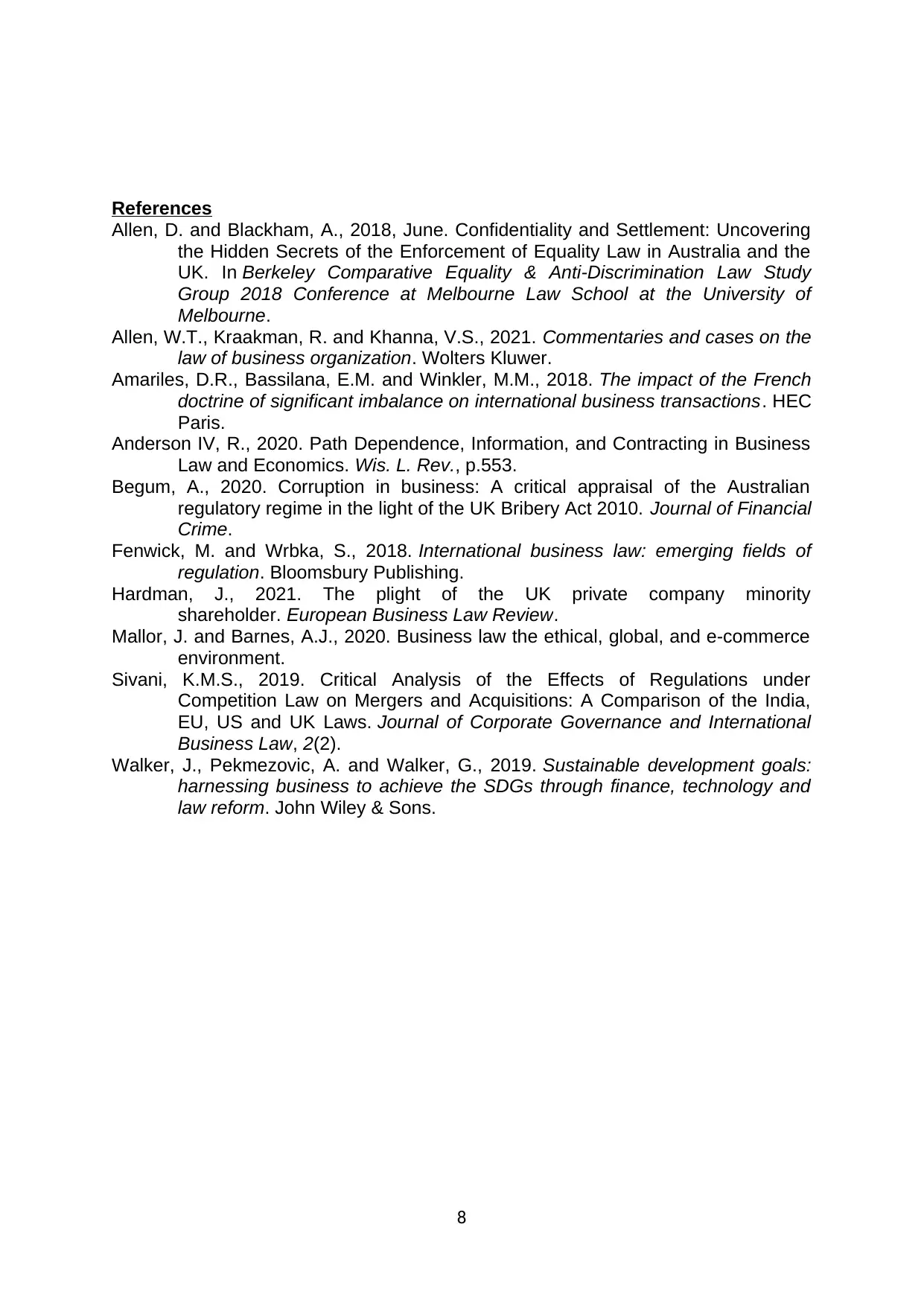
References
Allen, D. and Blackham, A., 2018, June. Confidentiality and Settlement: Uncovering
the Hidden Secrets of the Enforcement of Equality Law in Australia and the
UK. In Berkeley Comparative Equality & Anti-Discrimination Law Study
Group 2018 Conference at Melbourne Law School at the University of
Melbourne.
Allen, W.T., Kraakman, R. and Khanna, V.S., 2021. Commentaries and cases on the
law of business organization. Wolters Kluwer.
Amariles, D.R., Bassilana, E.M. and Winkler, M.M., 2018. The impact of the French
doctrine of significant imbalance on international business transactions. HEC
Paris.
Anderson IV, R., 2020. Path Dependence, Information, and Contracting in Business
Law and Economics. Wis. L. Rev., p.553.
Begum, A., 2020. Corruption in business: A critical appraisal of the Australian
regulatory regime in the light of the UK Bribery Act 2010. Journal of Financial
Crime.
Fenwick, M. and Wrbka, S., 2018. International business law: emerging fields of
regulation. Bloomsbury Publishing.
Hardman, J., 2021. The plight of the UK private company minority
shareholder. European Business Law Review.
Mallor, J. and Barnes, A.J., 2020. Business law the ethical, global, and e-commerce
environment.
Sivani, K.M.S., 2019. Critical Analysis of the Effects of Regulations under
Competition Law on Mergers and Acquisitions: A Comparison of the India,
EU, US and UK Laws. Journal of Corporate Governance and International
Business Law, 2(2).
Walker, J., Pekmezovic, A. and Walker, G., 2019. Sustainable development goals:
harnessing business to achieve the SDGs through finance, technology and
law reform. John Wiley & Sons.
8
Allen, D. and Blackham, A., 2018, June. Confidentiality and Settlement: Uncovering
the Hidden Secrets of the Enforcement of Equality Law in Australia and the
UK. In Berkeley Comparative Equality & Anti-Discrimination Law Study
Group 2018 Conference at Melbourne Law School at the University of
Melbourne.
Allen, W.T., Kraakman, R. and Khanna, V.S., 2021. Commentaries and cases on the
law of business organization. Wolters Kluwer.
Amariles, D.R., Bassilana, E.M. and Winkler, M.M., 2018. The impact of the French
doctrine of significant imbalance on international business transactions. HEC
Paris.
Anderson IV, R., 2020. Path Dependence, Information, and Contracting in Business
Law and Economics. Wis. L. Rev., p.553.
Begum, A., 2020. Corruption in business: A critical appraisal of the Australian
regulatory regime in the light of the UK Bribery Act 2010. Journal of Financial
Crime.
Fenwick, M. and Wrbka, S., 2018. International business law: emerging fields of
regulation. Bloomsbury Publishing.
Hardman, J., 2021. The plight of the UK private company minority
shareholder. European Business Law Review.
Mallor, J. and Barnes, A.J., 2020. Business law the ethical, global, and e-commerce
environment.
Sivani, K.M.S., 2019. Critical Analysis of the Effects of Regulations under
Competition Law on Mergers and Acquisitions: A Comparison of the India,
EU, US and UK Laws. Journal of Corporate Governance and International
Business Law, 2(2).
Walker, J., Pekmezovic, A. and Walker, G., 2019. Sustainable development goals:
harnessing business to achieve the SDGs through finance, technology and
law reform. John Wiley & Sons.
8
⊘ This is a preview!⊘
Do you want full access?
Subscribe today to unlock all pages.

Trusted by 1+ million students worldwide
1 out of 9
Related Documents
Your All-in-One AI-Powered Toolkit for Academic Success.
+13062052269
info@desklib.com
Available 24*7 on WhatsApp / Email
![[object Object]](/_next/static/media/star-bottom.7253800d.svg)
Unlock your academic potential
Copyright © 2020–2025 A2Z Services. All Rights Reserved. Developed and managed by ZUCOL.


